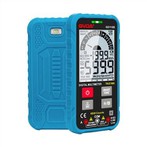The skill of measuring the quality of contactor coil with multimeter
Low-voltage coils are generally at the milliohm level, and the precise resistance value cannot be measured with a multimeter (the error is large), and a special direct resistance tester is required. However, it cannot be said that the measured value is the same or almost the same as the design value. It can be concluded that the coil is good. Sometimes the insulation damage between turns or layers of the coil cannot be measured with a multimeter. Wait until the point of failure can be found.
Use a digital multimeter to measure the coil with an ohm range below 2K to see if the coil is open circuited. If the circuit is open, it proves that the coil is broken.
Use a multimeter with ohm range 200 to measure normally closed and normally open (to measure normally open, hold it down with your hand or energize it). It indicates that the contact is not in good contact. If the auxiliary contact is connected to a load, the voltage will not reach the rated voltage when measuring the voltage.
Use a multimeter to measure the normally open and normally closed terminals to see if they are normal. It is not easy to measure the coil with a multimeter. The best way is to directly add the rated voltage to test the operation.
Method and principle of multimeter measuring AC voltage
Since the measuring device of the multimeter is a DC microamp meter head, when measuring the AC voltage, a rectification element must be introduced to form an AC voltmeter of the rectification system. The AC voltage block of the multimeter is an AC voltmeter with a large amount of current.
The rectification circuit of the multimeter can use half-wave rectification and full-wave rectification. The average current after rectification can be used to measure the DC voltage to measure the AC voltage. Since people are always used to measure AC voltage by effective value, the system on the dial of the multimeter is also expressed by effective value. The ratio of the effective current I to the average current I of the sinusoidal alternating current is called the form factor and expressed in Kf. For full-wave rectification Kf=1.11, for half-wave rectification Kf=2.22.
The actual multimeter AC voltage measurement circuit mostly uses the half-wave current reporting method. It can be seen from the above that when the measured AC voltage is in the positive half cycle, the half-wave full current passes through the positive terminal, multiplier resistors R3, R2, R1, Z1, and flows through the ammeter head to the negative terminal. When the measured AC voltage is in the negative half cycle, z1 is cut off, no current flows through the meter head, and the rectified current flows out from the positive terminal through z2, R1, R2 and R3. The rectifier in the multimeter generally adopts a semiconductor rectifier. There are generally two methods for measuring AC voltage. One is to use a set of multiplier resistors when measuring AC and DC voltages, and draw a scale line on the dial.
However, the voltage values on the two scale lines are quite different, so the two scale lines—k must be marked with the voltage value. The other is to use a set of multiplier resistors when measuring the AC and DC voltages, so that the same scale line can be used for the AC and DC voltage scales.






